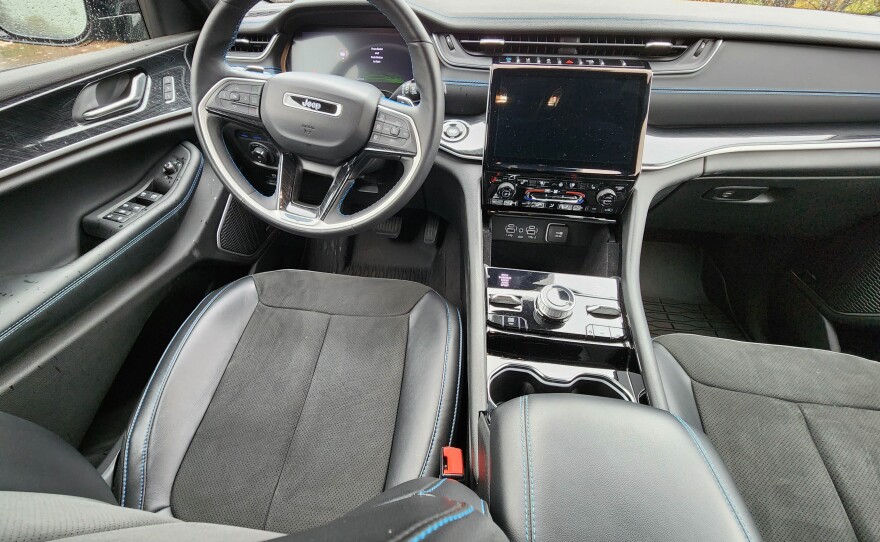When Jeep launched the Grand Cherokee 30 years ago it was among the first luxury sport-utility vehicles on the market that still was affordable (not a Rover) and capable of off-roading.
Jeep continues to make its Grand Cherokee as off-road worthy as anything, including its more rugged looking Wrangler, but the price now peaks at Range Rover levels.
Yet kudos to Jeep for adding hybrid power to its latest Grand Cherokee even though that’s what nudges the price up. This plug-in hybrid, the 4xe, is exactly what makes sense as the go-between from gas to electric power.
Here’s the deal.
On this mid-size SUV Jeep pairs a hybrid system with a small 2.0-liter turbo I4 so that an overnight charge on a normal home 120V power line nets 25 to 27 miles of electrical juice. That means that an average user who drives to and from work, or running their necessary daily errands, can use electricity most of the time. By the way, the power is amazingly smooth in the Jeep and when was the last time someone called a Jeep smooth?
In a 230-mile week of driving I evenly split my electric vs. gas powered driving, recharging with the driver’s side front quarter panel plug-in each evening.
That meant each morning I had a 100% charge and most days I didn’t need more than that. Two trips to the other side of town during the week meant half of each trip was on electric power, while the other half was gas-powered. The results? My combined average was 37.1 mpg, while gas alone (sadly Premium is recommended) averaged just 18.2 mpg, showing the difference hybrid electric power can make. The vehicle also senses when 4WD is not needed and turns it off when not needed.
It's also cool that Jeep allows the driver to select (via dash buttons) hybrid power, electric only or save-E, which mostly runs the Grand Cherokee on gas, saving the electric charge for when you most need it, say in town or when slopping around field or forest.
Yes, there are still plenty of off-roading choices here, five to be exact. A console toggle allows the driver to select Rock, Sand/Mud, Snow, Auto or Sport drive modes. Sport mode seems silly to me on an SUV and on this one, it considerably firms up the steering, which is not pleasant at all.
The others will engage the proper four-wheeling system for the circumstances and if you’re rock-crawling becomes a habit there’s a button to unhook the front sway bar to create more wheel articulation. Note too, the Grand Cherokee has a maximum ground clearance of 10.9 inches, which is a lot. Plus, another toggle on the console allows the driver to hike up the haunches and lift the Jeep to its maximum height or lower it for easy exits. This Jeep also will ford two feet of water safely.
There’s ample power here as the turbo I4 and hybrid electric motor provide a combined 375 horsepower and 470 pound-feet of torque so there’s a tow rating of 6,000 pounds. All is smooth and silky when electric is the power source, but when the Jeep switches to the gas engine, which is seamless, well, the little turbo groans considerably as it seems to be trying to bench press the vehicle’s full 5,500 lbs. Acceleration can be noisy with the tiny turbo.
Folks wanting constant smooth power application probably should opt for one of the gas-only powered Grand Cherokees that feature a V6 or V8. You’ll also save money up front, but more on that in a sec.
The handling is typical of a mid-size SUV, easy steering with modest feedback and a little body lean in tight turns. It’s all quite controllable and easy to maintain within a lane. Of course, there’s all the usual safety equipment such as lane departure, blind-spot warning and parking sensors.
The ride is mostly good too, especially on the highway. But as with most trucks, the ride gets much rougher on bumpy city streets as pot holes and expansion joints create some rock and roll. But then it’s a Jeep, right?
That’s not to say it isn’t luxurious. The Diamond Black Crystal Pearl ($395 extra) test SUV looked upscale with a mostly well-controlled ride and an interior leather.
I like the little blue styling cues on the exterior, to subtly insinuate this is a hybrid. Apparently, bright green and blue do that these days on hybrids and electrics. This one slapped blue trim on all the Jeep logos, the front and rear tow hooks, the rear hatch’s Trailhawk logo and a blue Trailhawk adhesive stripe on the hood, which also featured a flat black hood sticker.
Inside, the Grand Cherokee looks fresh and modern and took a big step up from its predecessor.
There’s plenty of black leather in the interior along with a tasteful blue (again) stitching to spruce it up. The seat edges were leather but the main seat surfaces a suede material. Classy.
Shiny black fake wood trim accents the dash and doors and is also trimmed in satin chrome. The look is keen, but the reflection from it and the gloss black console surface can be blinding on sunny days.
The seats are powered plus heated and cooled in the front, with the outer rear seats also heated. The steering wheel also is heated. One odd problem I found when trying to buckle up each trip is that the seatbelt is hard to pull between the seat and door. It can be a bit of a tight squeeze.
No problem with the digital equipment here though like the big center info screen and digital driver instrument panel. Some numbers on the driver display were a bit small, but the info screen was great and easy to use, plus includes adjacent volume and tuning knobs for the radio which is a fine Alpine sound system in the Trailhawk. Wireless Android Auto and Apple CarPlay are standard too.
A few things you won’t find on the Trailhawk were surprising though. There’s no sunroof, no wireless phone charger and no running boards. At this top-end pricing, I’d expect all three. In the Jeep’s defense, there are oodles of plug-ins available for charging.
There was no passenger-side info screen in the test vehicle but that’s OK. It’s an option on Jeep’s Wagoneer and Grand Wagoneer.
Tire noise is considerable with the beefy R18 All-Terrain tires, which would be good for off-roading, but hums loudly on city streets even at low speeds.
In the back is a power hatch hiding a load of cargo space, so a family of five can vacation, camp, haul, etc. while taking along all the sundries needed for comfort. The second-row seats split and fold flat and the SUV’s plug-in charger can be stowed neatly in a bag under the cargo floor.
Did I mention this is pricey?
Yes, and that was a bit of a shock (sorry) for this hybrid electric model. A base 2023 model (now at dealers) lists at $60,260, while a Trailhawk version starts at $65,455. Move up to an Overland and it’s $69,225 while a Summit goes for $72,990, and the premium of premiums, the Summit Reserve starts at $77,470 — all prices including delivery. For the record, a $7,500 tax credit may apply to the hybrid models, but check into before you buy.
The tested 2022 model listed at $64,280 and only added the special color to hit $64,675. By the way, white is the only paint color that doesn’t cost extra on the Grand Cherokee, although other colors are mostly $395, so not a huge add-on.
While I’m all in on plug-in hybrids until our electric infrastructure grows considerably, I should point out that Jeep really charges for the privilege. For instance, a base V6 powered Grand Cherokee, the Laredo, lists at $40,120, but of course has fewer standard features and no 4WD.
Move up to the equivalent Trailhawk gas-only model and the sticker is $56,030. Between are Altitude and Limited models in the mid-$40,000 range.
So choose wisely, especially if your budget already is being stretched. The good news for all 4xe plug-in hybrids, you’ll pay less to power them weekly, and they run as smooth as a luxury sedan, just taller and with way bigger tires!
FAST STATS: 2022 Jeep Grand Cherokee Trailhawk 4xe
Hits: Off-road capability, five drive modes, plug-in hybrid boosted gas mileage, and good looks. Roomy luxury interior, power hatch, heated/cooled front seats, heated outer rear seats, heated steering wheel, Alpine stereo, good safety equipment. Sway bar disconnect for off-roading and good ground clearance with toggle to raise truck.
Misses: Pricey, tire noise, groany underpowered gas engine, no sunroof, no running boards, no wireless charger, reflective trim, ride can get jiggly, tight seat butt pockets and front seat belts hard to pull through between door and seat.
Made in: Detroit, MI
Engine: 2.0-liter turbo I4, plug-in hybrid, 375 hp/470 torque
Transmission: 8-speed automatic
Weight: 5,521 lbs.
Wheelbase: 116.7 in.
Length: 193.5 in.
Cargo: 37.7-70.8 cu.ft.
Tow: 6,000 lbs.
MPG: 23/combo gas/electric
Fuel: Premium recommended
Electric range: 25 mph
MPG: 18.2 gas/37.1 combined (tested)
Base Price: $64,280 (includes delivery)
Invoice: $62,667
Major Options:
Diamond black crystal pearl paint, $395
Test vehicle: $64,675
Sources: Jeep, www.kbb.com













